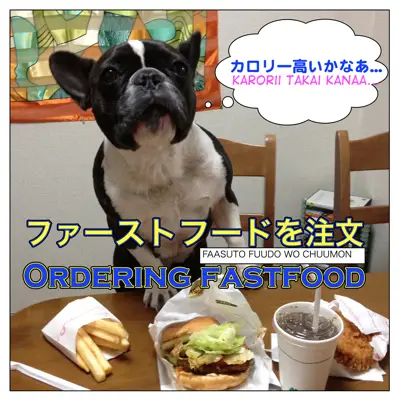
「カロリー高いかなあ….」
= Karorii takai kanaa….
=I wonder if it is high in calories…
Hi everyone!
Are you hungry? お腹すいた?= Onaka suita?
Today’s lesson is about ordering food at fast food restaurants.
A few people have been asking for me to make a lesson about fast food restaurants for a while, and I finally found some time to work on it.
Sorry it took me so long.
You may think you don’t need so much Japanese at a fast food restaurant.
But I think you’ll find it useful and you’ll know what you are being asked and how to order what you want.
I’ve included a lot of phrases that you may hear at a typical fast food restaurant.
⭐️ At a regular American style fast food restaurants.
*When you enter, they will say
( “S” for a person behind the counter. )
S. Ex. いらっしゃいませ!
= Irasshaimase!
= Welcome!
If there is a long line at a counter, they will call you
S. Ex. お次の方どうぞ!
= Otsugi no kata douzo!
= Next please!
S. Ex. お次でお待ちの方、どうぞ
= Otsugi de omachi no kata, douzo.
= (Literal meaning) The next person who has been waiting please go ahead and order.
= Next, please.
If you order out of turn, they may say
S. Ex. 申し訳ございません。順番にご注文を伺っております。
= Moushiwake gozaimasen. Junban ni gochuumon wo ukagatte orimasu.
= We are very sorry, but we are taking the orders in order.
S. Ex. あちらの列にお並び頂けますでしょうか?
= Achira no retsu ni onarabi itadakemasu deshouka?
= Could you stand in that line, please?
S. Ex. お待たせいたしました。
= Omatase itashimashita.
= (Literal meaning) We are sorry to have kept you waiting
= Thank you for waiting.
When you order food at a counter, they’ll first ask you
S. Ex. こちらでお召し上がりですか?
= Kochira de omeshiagari desuka?
= (Literal meaning) Are you going to eat here?
= Are you eating in?
S. Ex. 店内でお召し上がりですか?
= Tennai de omeshiagari desu ka?
= (Literally) Are you going to eat in the store?
= Are you eating in?
S. Ex. (それとも)お持ち帰りですか?
= (Soretomo) omochikaeri desu ka?
= (Or) To go?
If you want to eat there, you say
⬇️
Ex. ここで食べます
= Koko de tabemasu.
= (Literal meaning) I will eat here.
= For here/ Eating in.
Ex. テイクアウトで。or テイクアウトします。
= Teiku auto de, / Teiku auto shimasu.
= To go please.
Ex. 持ち帰りで(お願いします。)
= Mochikaeri de (onegai shimasu.)
= To go (please).
S. Ex. (それでは)ご注文をお伺い致します。
= (Sore de wa) gochuumon wo oukagai itashimasu.
= (Literal meaning) I will take your order now.
= Can I take your order?
S. Ex. こちらでご注文をお伺い致します。
= Kochira de gochuumon wo oukagai itashimasu.
= I will take your order (now).
Note: こちら(= kochira) means “here” and it is a polite way to say ここ(= koko) “here”
Also あちら(= achira) is a polite way to say あっち( = acchi) / あそこ(= asoko) “over there”
S. Ex. ご注文はお決まりですか?
= Gochuumon wa okimari desuka?
= Are you ready to order?
Ex. はい
= Hai
= Yes
If the menu list at the counter has all the pictures of food and prices, even if you don’t speak Japanese well, you can just point at the picture of the food you like and say これ( = kore), this one , and add お願いします。( = onegai shimasu.), please.
Ex. これ1つお願いします。
= Kore hitotsu onegai shimasu.
= One of this please.
Tell them how many of them you want:
![]() *~つ(お願いします。)
*~つ(お願いします。)
= ~ tsu (onegai shimasu.)
![]() *~個(お願いします。)
*~個(お願いします。)
= ~ ko (onegai shimasu)
Counters in Japanese are a bit complicated and change depending on the item, it’s shape, size, etc. (Check How to count lesson.)
I will teach you the most general counters here.
*1 piece = 1個= ikko / 一つ / 1つ = hitotsu
*2 pieces = 2個 = niko / 二つ / 2つ= futatsu
*3 pieces = 3個 = sanko / 三つ / 3つ= mittsu
*4 pieces= 4個 = yonko / 四つ /4つ= yottsu
*5 pieces= 5個 = goko / 五つ / 5つ= itsutsu
Ex. チーズバーガー1つとフィレオフィッシュ1つ(お願いします。)
= Chiizu bagaa hitotsu to fireofisshu hitotsu (onegai shimasu.)
= One cheeseburger and one filet-o-fish please.
Ex. ビックマック1つ(お願いします。)
= Bikku makku hitotsu (onegai shimasu.)
= One big Mac (please)
They may repeat your order
S. Ex. ビックマックおひとつですね。
= Biggu makku ohitotsu desune.
= One big Mac, right?
Note: They add お(=o) in front of the number to sound more polite.
S. Ex. セットにされますか?
= Setto ni saremasu ka?
= Would you like to make it a combo?
Ex. セットで(お願いします。)
= Setto de (onegai shimasu.)
= Make it a combo (please)
When you don’t order a “set-meal”
Ex. 単品で(お願いします。)
= Tanpin de (onegai shimasu.)
= Just a big Mac burger. (please)
Note: 単品(=tanpin) literally means “single item”
If you want to ask if there is a combo or not,
Ex. セットはありますか?
= Setto wa arimasuka?
= Does that come in a set or combo?
S. Ex. こちらがセットメニューとなっております。
= Kochiraga setto menuu to natte orimasu.
= This (These) is/ are the set meal.
S. Ex. ポテトかサラダからお選び頂けます。
= Poteto ka sarada kara oerabi itadakemasu.
= You can order french fires or salad.
S. Ex. お飲み物はいかがですか?
= Onomimono wa ikaga desu ka?
=Would you like something to drink?
Ex. コーラお願いします。
= Koura onegai shimasu.
= A coke please.
S. Ex. サイズはどうされますか?
= Saizu wa dousaremasuka?
= What size would you like?
(more polite)
S. Ex. サイズはいかがなさいますか?
= Saizu wa ikaga nasaimasuka?
= What size would you like?
Ex. Mサイズで(お願いします。)
= Emu saizu de (onegai shimasu.)
= A medium (please)
Ex. スプライトMサイズ1つ(お願いします。)
= Supuraito emu saizu hitotsu (onegai shimasu.)
= One medium size Sprite (please).
Ex. コーヒー1つお願いします。
= Koohii hitotsu onegai shimasu.
= One coffee please.
Usually you count a cup of coffee as 一杯 ( = ippai) but you can say 一つ( = hitotsu) for ordering coffee at a fast food store.
S. Ex. アイスですか?ホットですか?
= Aisu desuka ? Hotto desu ka?
= Iced coffee or hot coffee?
S. Ex. コーヒーにはS/M/Lと3つのサイズがございますが。
= Koohii niwa esu/ emu / eru to mittsu no saizu ga gozaimasu ga.
= There are three sizes for coffee, Small, Medium and Large..
If you are at a Starbucks, you have to be more specific.
Ex. カフェモカのショート一つお願いします。
= Kafe moka no shooto hitotsu onegai shimasu.
= One short Cafe Moca please.
Ex. トールの抹茶クリームフラペチーノ、チョコチップ追加でシロップ抜きでお願いします。
= Tooru no maccha kuriimu furabechiino, chokochippu tsuika de shiroppu nuki de onegai shimasu.
= One tall Maccha cream frappucchino with chocolate tips and without syrup please.
Ex. ショートのキャラメルマキアートを豆乳でお願いします。
= Shooto no kyarameru makiaato wo tounyuu de oneagi shimasu.
= One short Caramel Macchiato with soy milk, please.
S. Ex. サイドオーダーはいかがですか?
= Saido oodaa wa ikaga desuka?
= Will that be all? / Would you like anything else. (Literally: Would you like a side order?)
S. Ex. ポテトはいかがですか?
= Poteto wa ikaga desu ka?
= Would you like french fries?
S. Ex. サイズはMでよろしかったですか?
= Saizu wa emu de yoroshikatta desuka?
= Will medium size be OK?
If you go to a sandwich store, you have to choose the type of bread you like.
Ex. ローストターキ一つお願いします。
= Roosuto taakii hitotsu.
= One roast turkey (please)
S. Ex. パンの種類は如何なさいますか?
= Pan no shurui wa ikaga nasaimasu ka?
= What type of bread would you like?
S. Ex. ドレッシングはどれになさいますか?
= Doresshingu wa dore ni nasaimasu ka?
= Which dressing would you like?
S. Ex. お好みのドレッシングをお選び下さい。
= Okonomi no doresshin wo oerabi kudasai.
= Please choose the dressing you would like.
Ex. ハニーオーツをレギュラーサイズ、バルサミコソースでお願いします。
= Hanii ootsu wo regyuraa saizu , barusamiko soosu de onegai shimasu.
= With regular size Honey oats bread and balsamic sauce please.
S. Ex. 有料でお好きなトッピングを追加頂けます。
= Yuuryou de osukina toppingu wo tuika itadakemasu
= Extra toppings are available for an additional charge.
S. Ex. 追加料金でトッピングをお選び頂けますがいかがですか?
= Tsuika ryoukin de toppingu wo oerabi itadakemasu ga ikaga desu ka?
= You can choose the toppings you’d like for an extra charge.
Ex. いえ、結構です。
= Ie kekkou desu.
= No thank you.
S. Ex. お野菜はすべてお入れしてもよろしかったでしょうか?
= Oyasai wa subete oire shite mo yoroshi katta deshouka?
= Will be it OK if I put in all the vegetables?
S. Ex. 具は全て入れますか?
= Gu wa subete iremasu ka?
= Do you want it with everything?
Ex.はい、全部入れて下さい。
= Hai, zenbu irete kudasai.
= Yes, put all of them please.
Ex. 玉ねぎ以外、全て入れて下さい。
= Tamanegi igai, subete irete kudasai.
= Everything but onions please.
or
Ex.玉ねぎ抜きでお願いします。
= Tamanegi nuki de onegai shimasu.
= No onions please.
Ex. はい、ピクルス多めでお願いします。
= Hai, pikurusu oome de onegai shimasu.
= Yes, a lot of pickles please.
Ex. 玉ねぎ少なめでお願いします。
= Tamanegi sukuname de onegai shimasu.
= With less onions, please.
S. Ex. (パンは)トーストされますか?
= (Pan wa) Toosuto saremasuka?
= Would you like it toasted?
Ex. はい、お願いします。
= Hai, onegai shimasu.
= Yes, please.
S. Ex. セットにされますか?
= Setto ni saremasu ka?
= Would like to make it a combo?
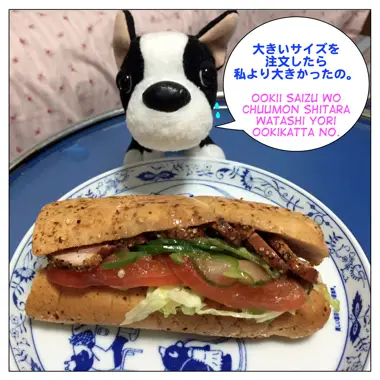
「大きいサイズを注文したら私より大きかったの。」
= Ookii saizu wo chuumon shitara watashi yori ookikatta no.
= I ordered a large but it ‘s even bigger than me….
⭐️ Sometimes they suggest a special menu.
S. Ex. こちら期間限定でてりやきチキンバーガーがございますが、いかがでしょうか?
= Kochira kikan gentei de teriyaki chikin baagaa ga gozaimasu ga, ikaga de shouka?
= Would like to try our special teriyaki chicken burger? It’s available for a limited time only.
*期間限定= kikan gentei = limited time offer
⬇️
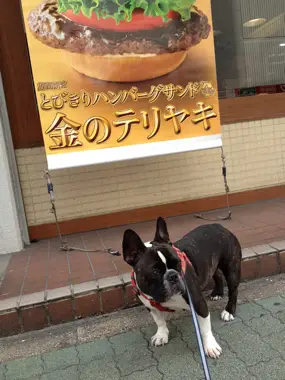
S. Ex. . 新作のバナナケーキも如何ですか?
= Shinsaku no banana keiki mo ikaga desuka?
= Would like to try our new banana cake,too?
If you don’t want it you can say
Ex. いえ、結構です。
= Ie, kekkou desu.
= No, thank you.
Ex.またにします。
= Mata ni shimasu.
= I will try it next time.
⭐️ Ordering a set meal
Ex. セットメニューはありますか?
= Setto menyuu wa arimasuka?
= Do you have a set meal?
Ex. ドリンクセットお願いします。
= Dorinku setto onegai shimasu.
= One “drink-set” meal please.
( A meal comes with a drink.)
Ex. ハッピーセット一つお願いします。
= Happii setto hitotsu onegai shimasu.
= One Happy Set please.
S. Ex. お飲み物をお選びください
= Onomimono wo oerabi kudasai.
= (literally) Please choose drinks from here.
=What would you like to drink?
S. Ex. お飲み物は、こちらからからお選びください
= Onomimono wa kochirakara oerabi kudasai.
=Please select your drink from these.
S. Ex. ドリンクはこの中からお選び頂けます。
= Dorinku wa kono naka kara oerabi itadakemasu.
= You can choose your drink from here.
Ex. じゃあ、カプチーノで。
= Jaa kapuchii no de.
= Then I’ll have a Cappucchino.
S. Ex. プラス50円でキャラメルラテかカフェラテがお選び頂けますが。
= Purasu gojuuen de kyaramerurate ka kaferate ga oerabi itadake masu ga.
= If you pay 50 yen extra, you can get caramel Latte or Cafe Latte.
Ex. じゃあお願いします。
= Jaa onegai shimasu
= Then please. (I will pay 50 yen extra)
S. Ex. 他にご注文はよろしかったですか?
= Hoka ni gochuumon wa yoroshikatta desu ka?
= Would like to order anything else?
S. Ex. ご注文は以上でよろしかったでしょうか?
= Gochuumon wa ijou de yoroshikatta deshou ka?
= Will that be all?
S. Ex. ご注文を確認させて頂きます。
= Gochuumon wo kakuknin sasete itadakimasu.
= Let me confirm your order.
S. Ex. ダブルバーガー1つとポテトのMを1つ。以上でよろしいでしょうか?
= Daburu baagaa hitotsu to poteto no emu wo hitotsu. Ijou de yoroshii deshouka?
= One double burger and one medium french fries. Will that be all?
S. Ex. チーズバーガーお1つ、Mサイズのポテトがお1つ、Mサイズのコーラーお1つでお間違いありませんか?
= Chiizu baagaa ohitotsu, emu saizu no poteto ga ohitotsu, emu saizu no koora ohitotsu de omachigai arimasen ka?
= One cheeseburger, One medium french fries and one medium Coke. Is that right?
Ex. はい
= Hai
= Yes
If you want to add something else,
Ex. すみません、あとチキンナゲットもお願いします。
= Sumimasen, ato chikin nagetto mo onegai shimasu.
= Sorry. I would like to order chicken nuggets as well.
S. Ex. ごゆっくりどうぞ
= Goyukkuri douzo.
=(Literally) Please take your time.
= Please enjoy your meal.
⭐️ Ask for something.
Ex. ストロー下さい
= Sutoroo kudasai.
= Can I have a straw?
if you want to say more politely
Ex. ストロー頂けますか?
= Sutoroo itadakemasu ka?
= May I have a straw please?
Ex. ケチャップ下さい。
= Kecchappu kudasai.
= May I have some ketchup?
Ex. ガムシロップはどこにありますか?
= Gamushiroppu wa doko ni arimasu ka?
= Where’s the sugar syrup (portion syrup)?
Ex. フォーク(を)もう一本下さい。
= Fooku (wo) mouippon kudasai.
= May I have another fork, please?
Ex. すみません、スプーンありますか?
= Sumimasen, supuun arimasu ka?
= Excuse me. Do you have a spoon?
⭐️ Sometimes your need to wait your order somewhere else. Or you get a number and they will call you out when your order is ready.
S. Ex. あちらのカウンターでお待ち下さい。
= Achira no kauntaa de omachi kudasai.
= Please wait at the counter over there.
S. Ex. こちらの番号をお持ち下さい。
= Kochira no bangou wo omochi kudasai.
= Please take this number with you
S. Ex. 出来上がりましたら番号でお呼び致します。
= Dekiagarimashitara bangou de oyobi itashimasu.
= We will call your number when it is ready
S. Ex. 10番でお待ちの方
= Juuban de omachi no kata
= (Literal meaning) the person who has been waiting with Number 10.
= No. 10!
When you are at the restaurant, fast food stores or any stores in Japan, they will refers to you as お客様(=okyaku sama ) / お客さん(=okyaku san). It is an honorific way to call “guests/ customers/clients”
⬇️
S. Ex. 10番でお待ちのお客様
= Juuban de omachi no okyaku sama
= (Literal meaning) A customer (person) who is waiting with a number 10.
= Number 10?
S. Ex. ショートのハニーミルクラテでお待ちのお客様
= Shooto no hanii miruku rate de omachi no okyaku sama.
= (literal meaning) A customer/ a person who is waiting for short honey milk latte.
= Short honey milk latte is ready
Or they may bring your order to your table
S. Ex. テーブルでお待ち下さい。
= Teiburu de omachi kudasai.
= Please wait at the table
S. Ex. お席でおかけになってお待ち下さい。
= Oseki de okake ni natte omachi kudasai.
= Please sit down and wait.
S. Ex. お席までお持ち致します。
= Oseki made omochi itashimasu.
= We will bring your order to your table.
⭐️ Paying for the food
S. Ex. お会計はこちらでお願い致します。
= Okaikei wa kochira de onegai itashimasu.
= Please pay here.
S. Ex. お会計千円になります。
= Okaikei senen ni narimasu.
= That’ll be 1,000 yen.
⭐️ Other possible questions that you may want to ask:
If you don’t know what to do with the tray
Ex. トレイはどうしたらいいですか?
= Torei wa doushitara ii desu ka?
= What should I do with the tray?
S.Ex. そのままで結構です。
= Sonomama de kekkou desu.
= Please leave it.
S. Ex. トレイはあちらにお戻し下さい。
= Torei wa achira ni omodoshi kudasai.
= Please take your tray over there.
Ex. トイレはどこですか?
= Toire wa doko desuka?
= Where is the restroom?
Ex. お手洗いはどこですか?
= Otearai wa doko desu ka?
= Where is the restroom?
⭐️ Buying meal tickets
Fast food is not just hamburgers or fried chicken.
There are many fast food restaurants where they serve Japanese food as well such as 牛丼 (= gyuudon) beef bowl orラーメン(= raamen) ramen noodle,
That might be a little challenging for you because a lot of places don’t have English menus.
Ex. 英語のメニューはありますか?
= Eigo no menyu wa arimasu ka?
= Do you have an English menu?
If they do, they will just give it to you but if they don’t they will say
S. Ex. (申し訳ございません。) ありません。/おいていません。
= (Moushiwake gozaimasen. ) Arimasen/ Oite imasen.
= (We are very sorry but) We don’t (have an English menu.)
And there are places you have to buy 食券(=shokuken) meal tickets.
*食券売り場/ 食券売場
=shokken uriba
= the place where they sell meal tickets
*食券販売機
=Shokken hanbaiki
= A meal ticket vending machine
or some advanced restaurants order food with a little device on the counter
So in this section I will give you the basic vocabulary that you may see/hear at Japanese fast food restaurants.
S. Ex. 食券はあちらでお求め下さい。
= Shokkenwa achira de omotome kudasai.
= Please buy meal tickets over there.
S. Ex. まず食券を買って下さい。
= Mazu shokken wo katte kudasai.
= Buy meal tickets first please.
If you don’t know where to buy a meal ticket,
Ex. 食券はどこで買ったらいいですか?
= Shokken wa doko de kattara iidesuka?
= Where can I buy a meal ticket?
And if you don’t know how to buy a ticket,
Ex. 食券の買い方がよくわからないので教えて頂けますか?
= Shokken no kaikata ga yoku wakaranai node oshiete itadakemasu ka?
= I don’t know how to buy a meal ticket. Could you tell me how to buy a ticket?
*セット= setto = meal set
*単品= tanpin = (literal meaning) individual/single item
→ ordering something à la carte (not set meal)
*味噌汁= misoshiru = miso soup
*漬け物= tsukemono = Japanese pickles
*玉子・卵= tamago = egg
*追加= tsuika = additional order
*ご飯= gohan = rice
*麺= men = noodle
⭐️The portion of food, rice or noodle
*並盛(り)= namimori = regular portion
(We also say 普通= futsuu)
Note: Quality of food
並(=nami) means “normal/standard” (= 普通=futsuu)
You also use it to describe the quality of food.
If you see the word 上 ( = jou) it means “good” and 特上( = tokujou) means “excellent”.
So the price will go up naturally.
並 (=nami) →上 ( = jou) →特上 ( = tokujou)
*大盛(り)= oomori = large portion
*特盛(り)= tokumori = extra large portion
(or this is a relatively new word but we also say メガ盛(り)= mega mori)
⭐️ Changing the order in a set menu.
Some of the set menu allow you to change (= 変更 = henkou) the food,
⬇️
*セットの味噌汁を豚汁に変更
= Setto no misoshiru wo tonjiru (or butajiru) ni henkou
= Change “(regular) miso soup” to “miso soup with porc and vegetables”
⭐️ Toppings for noodle or rice:
*ネギ=negi = green onion
*卵・玉子= tamago = egg
*味玉= ajitama ・味付け卵= ajitsuke tamago = boiled egg which was soaked in soy sauce
* 半熟煮卵= hanjuku nitamago = half-boiled egg which was soaked in soy sauce
*のり・ノリ・海苔= nori = dried seaweeds
*チャーシュー= chaashuu = sliced roasted pork
*メンマ= Menma = condiment made from lactate-fermented bamboo
(English translation is very mysterious, huh? Please see the picture below.)
*天ぷら= tenpura = Tempura (deep fried shrimp, fish, vegetable)
*紅ショウガ(生姜)= beni shouga = red pickled ginger
⭐️ How to buy tickets from a machine
Paying money to a vending machine shouldn’t be too difficult.
There are slots for bills and coins.
But when you need change, you may have to push the button or press the lever which says
*おつり/ お釣り= otsuri = change
*(おつり)返却(口) = ( otsuri) henkyaku (guchi) = return slot
In case you have a trouble getting your change back, tell someone
Ex. おつりが出ません。
= Otsuri ga demasen.
= I can get any change back.
Ex. 千円入れたのですがお釣りが出ません。
= Senen ireta no desu ga otsuri ga demasen.
= I paid one thousand yen but I can’t get the change back.
I made a sample vending machine for マギー屋 ( =Maggie ya).
What would you order? :)
⬇️
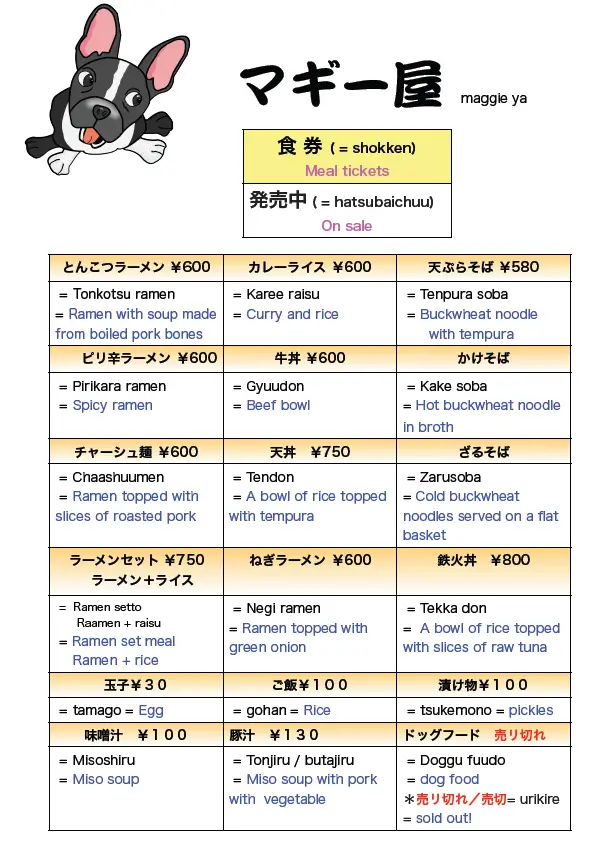
⭐️ At a Ramen shop
There are many kinds of ramen but basically you choose the type of soup.
*豚骨ラーメン= tonkotsu ramen = ramen with soup made of pork bone.
*塩ラーメン = shio ramen = ramen with salt and chicken, pork or fish bases soup
*味噌ラーメン = miso ramen = ramen with miso based soup
*醤油ラーメン = shouyu ramen = ramen with soy sauce based soup
Ex. 味噌ラーメン一杯お願いします。
= Miso raamen ippai onegai shimasu.
= One miso ramen please.
Ex. 塩ラーメン大盛りで
= Shio raamen oomori de.
= One large (portion of) ramen with salt based soup
Ex. にんにくはいれないで下さい。
= Ninniku wa irenai de kudasai.
= No garlic please.
Ex. にんにく抜きでお願いします。
= Ninniku nuki de onegai shimasu.
= No garlic please.
Ex. 替え玉お願いします。
= Kaedama onegai shimasu.
= Refill of the noodle please.
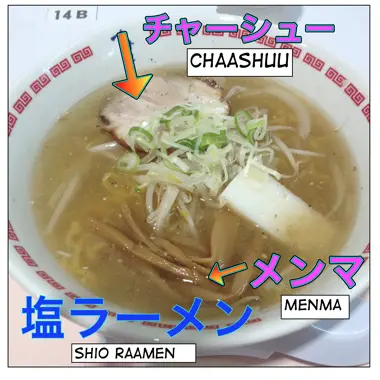
⭐️ 丼 = donburi = rice bowl topped with something
Note: Usually we serve rice in ご飯茶碗 = gohan jawan = rice bowl.
A big rice bowl is called 丼 ( = donburi)
And the food which is served in 丼( = donburi) ( is called 丼もの= donburi mono, rice bowl topped with something
*牛丼 = gyuudon= beef bowl
*天丼 = tendon = tempura on rice
*親子丼 = oyakodon= simmered egg and chicken on rice ( 親子 = oyako means “parents and child” → “chicken and “egg”)
*鰻丼 = うな丼= unadon = grilled eel on rice
*カツ丼 = katsudon = deep fried pork cutlets on rice
*海鮮丼 = kaisen don / kaisen donburi = fresh seafood (sliced sashimi (raw fish) ) on rice, etc.
*定食 = teishoku = set menu
→魚定食 = sakana teishoku = set menu with fish
→ 日替わり定食 = higawari teishoku = a set meal that changes from day to day
Ex. ご飯少なめで(お願いします。)
= Gohan sukuname de (onegai shimasu)
= With less rice (please)
Ex. ご飯、大目で(お願いします。)
= Gohan, oome de (onegai shimasu)
= With large portion of rice (please)
At a 牛丼屋 = gyuudonya = beef bowl shop
There is some lingo…
*つゆだく= tsuyudaku = extra/ additional beef sauce/juice
Ex. つゆだくで(お願いします。)
= Tsuyudaku de (onegai simasu.)
= With more sauce (please)
If you don’t want to have any sauce, you say
*つゆぬきで(お願いします。)
= Tsuyu nuki de (onegai shimasu.)
= Without sauce (please)
*ねぎだく= negidaku = additional of chopped green onions
Ex. ねぎだくで (お願いします。)
= Negidaku de (onegai shimasu.)
= With more green onions please.
If you don’t need any green onions, you say
Ex. ねぎぬきで(お願いします。)
= Neginuki de (onegai shimasu.)
= No green onions please.
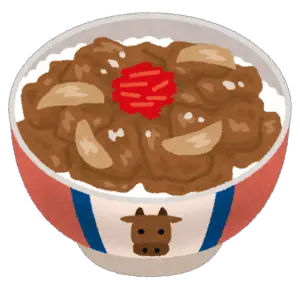
⭐️ Soba or udon noodle
*そば= soba = buckwheat noodle
*うどん = udon = wheat noodle
When you go to そば屋 ( =sobaya) soba noodle shop or うどん屋(=udon ya) udon oodle shop you have to choose
冷たい (= tsumetai ) cold or 温かい ( = atatakai) hot noodles.
*かけうどん ( =kake udon) / かけそば ( = kake soba)
:u:

The word かけ ( = kake) (←掛ける= kakeru) , it means to pour something onto the noodle.
*つけ麺= tsukemen = dipping noodle
When you see the word つけ ( = tsuke) (←”つける = tsukeru” ) and it means “to dip”. So they serve sauce separately and you dip the noodle into the sauce.
*ざるそば ( = zaru soba) or ざるうどん ( = zaru udon)
They serve cold noodle in the bamboo basket called ざる( = zaru) and you eat the noodle dipped in cold sauce.
⬇️

Sometimes you just say
ざる( = zaru) and かけ( = kake)
Ex. ざるでお願いします。
= Zaru de onegai shimasu.
= A cold noodle (in a bamboo basket)
Ex. かけでお願いします。
= Kake de onegai shimasu.
= (Hot) Noodles in hot dashi soup, please.
Whew. This turned out to be another long lesson.
Here are links for my other food related lessons.
⬇️
*コーヒーショップ & レストラン = Cofee shop & Restaurant
******
 マギー先生より= Maggie Sensei yori = From Maggie Sensei
マギー先生より= Maggie Sensei yori = From Maggie Sensei
私のおすすめはライスバーガーですよ。
= Watashi no osusume wa raisubaagaa desu yo.
= I highly recommend “rice burger”
日本に来たら、是非食べてみて下さいね。
= Nihon ni kitara, zehi tabete mite kudasaine.
= You should definitely try it when you come to Japan.
***
Will you be my Patron?
I appreciate your support! サポートありがとう!

44 Comments
初めまして、マギー先生。ガビです。質問があります!
I’m confused on when to で vs をください/おねがいします when ordering.
例えば: 「セットでお願いします」とか「コーラのMサイズで」とか「お茶でお願いします」などです。vs 「コーヒーをください」、「コーラのSサイズを一つお願いします」などです。 「でお願いします」か「をお願いします」は I’m not sure which one would be correct to answer with for certain situations or is it just up to personal preference?
こんにちは、ガビ 😊
Both を and で can be used when ordering things, but there is a nuanced difference between them
を: Use を when indicating something specific or emphasizing what you want (→What I want is ~).
コーラを/コーヒーを/セットを + ください/お願いします.
で: Use で when selecting something out of a few/several/many choices.
コーラで/コーヒーで/セットで + (お願いします* You can sometimes omit お願いします and just say ~で).
While で might sound a little softer than を, if you say ~でいいです, it expresses the nuance of compromising, so you have to be careful when you use it.
I am now actually working on a new lesson on the particle で. So I will cover this usage for you. 😉
Hi Maggie sensei!
Thank you for your very informative site!
Would like to know what does the ‘で’ in following examples mean? What is the function of ‘で’ in these examples?
– Ex. 持ち帰りで(お願いします。)
– Ex. Mサイズで(お願いします。)
Thank you!!
Hi Chan
When you order something or ask for something choosing from multiple choices/options, you use で
There are Small, Medium, Large →Mサイズで
You choose out of take away or eat in, →持ち帰りで
Another example. When you order ramen there are a few options.
Ex. 大盛りでお願いします。 large portion
Ex. みそでお願いします。 miso ramen
Thank you for the explanation!
You’re very welcome, Chan! :)
Ohayo, Maggie-sensei! I have a question on ordering from a restaurant. For example, if I’m looking to buy one set of dango, would it be: “Dango hitotsu, onegai shimasu”? And would it be the same for other numbers, or does vocabulary change as the numbers increase? I’m sorry if my question is a bit odd, I’m still learning the basics. ^^;
Hi Taylor
Haha, actually it’s a good question.
One dango is 団子一本ください。( Dango ippon kudasai.) 🍡
When you want a pack of dango (several dangos are in one package) you point the package and say
これ、ひとつください。(= Kore hitotsu kudasai.)
or
おだんご、1パックください。
これ、1パックください。
If several dango are ine packages,
Thank you very much!
You’re welcome!
Let me add one more.
For example if the package has five dangos, you can say
Ex. この5本入りの(だんご)、一つください。= kono gohon iri no (dango) hitotsu kudasai.
Thank you very much!
How would you say ‘ extra 1/2/3 more patties’?
Hi Lou,
The way you call them depends on the burger shop.
double patties 二段パティー (nidan patties) /倍パティー (bai patties) / ダブルパティー (double patties)
triple patties 三段パティー (sandan patties) /トリプルパティー (triple patties) ,etc.
Thank you very much.I found it very usefull to me.please keep teachingus like this.
My pleasure! I’m glad to hear that you found this lesson useful. :)
Hello 先生!Thank you for this incredibly useful lesson! I’m going to Japan in July on vacation so I’m trying to get used to keigo, baito keigo and all the expressions used in shops! :D
I have been thinking about a sentence from the lesson, there are two things I don’t understand:
S. Ex. 有料でお好きなトッピングを追加頂けます。
1) The patterns that I’m used to are:
-te itadakemasu
-noun wo itadakemasu
but this seems different:
トッピングを 追加 頂けます。
nounA wo nounB itadakemasu.
Maybe there is a ‘hidden’ して (追加して頂けますで) ?
2) In terms of meaning, it also seems strange, but I cannot explain clearly beacause I’m not sure about 1). But basically if I say for example お金を貸して頂けませんか? the person humbly receiving the favour and the person doing the action (lending money) are two different people. This also happens in S. Ex. ポテトかサラダからお選び頂けます。from this lessson. But in お好きなトッピングを追加頂けます。 it seems that the person humbly receiving the favour (= the store clerk) is also the person doing the action (adding the toppings).
As always, thank you for your valuable help.
Hi Davide,
You are coming to Japan next month. How exciting!
OK, you can also say 追加していただけます。
The usage of
(お/ご)〜いただける/いただけます。
1) いただけますか?
You tell someone superior to do something.
お待ち(して)いただけますか? Could you wait?
ご覧いただけますか? Could you take a look?
いただけませんか? (more polite than いただけますか?)
お金を貸していただけませんか? (asking for a favor)
You ask someone superior to do something for you.
2) 〜いただけます。= The listener can get some benefit(not the speaker). / You can do something. / It is possible for you to do something.
The waiter is telling the customers that the customers can…
お選び頂けます。 can choose
こちらからご注文頂けます。order from here.
トッピングを追加頂けます。 add the topping.
日本に行くのをとても楽しみにしています 😍
Now that you say it like that, ‘can add the topping’ makes sense. I think I was interpreting this too literally. Thank you so much!
I’ve noticed you have lessons on keigo and kenjougo. I’ll be sure to check those out too!
Yes, I have a lessons on keigo and kenjougo. :)
I am also excited to hear about your trip!!
Hi Maggie Sensei,
Can you teach me how to order at a takoyaki store? I noticed that you can buy them in 4 pieces, 6 pieces or 8 pieces (sometimes even more).
How would you say the following in Japanese:
I would like to buy 2 orders of 8 pieces in each.
I would like to buy 1 order of 8 pieces and 1 order of 4 pieces.
Hi Steve,
Haha you like takoyaki? Me,too! 😋
I would like to buy 2 orders of 8 pieces in each.
8個入りを2つください。
= Hachiko iri wo futatsu kudasai.
I would like to buy 1 order of 8 pieces and 1 order of 4 pieces.
8個入りを一つと4個入りを一つください。
= Hachiko iri wo hitotsu to yonko iri wo hitotsu kudasai.
This is one of my favorite lessons of yours. Getting food is something I always have trouble with when I travel, and I love eating out, so… But I have never seen anyone give so much detail about “what will happen when you go to [insert place]” as you. I like that you always think of as many situations as possible. Thank you so much!
Hi Chan,
Haha I know this lesson is long but I am glad to hear you like it.
Eating is very important. Enjoy eating out in Japan. 😉
Hi Maggie sensei! Thank you so much for all your detailed and helpful posts!
I was wondering how to order ice-cream. Such as when you can customize how many/which flavours you want, the size, and in a cup or cone. For example: “Medium size please, with vanilla and matcha in a cone”
Thank you!
Hi Krissy
You can use this pattern.
バニラと抹茶のMサイズをコーンでお願いします。
= banira to maccha no emu saizu wo koon de onegai shimasu.
or
Mサイズのバニラと抹茶をコーンでお願いします。
= Emu saizu no banira to maccha wo koon de onegai shimasu.
Maggie –
When I order meat, do they ask the equivalent of “how would you like it cooked”? What would that be, and how would I respond?
Thanks!
Hi バッド!
You say
お肉*の焼き加減はどうしますか?/ more polite)いかがなさいますか?
= Oniku* no yakikagenn wa dou shimasu ka? / (more polite) ikaga nasaimasu ka?
*steak = ステーキ
レア/ミディアムレア/ミディアムウェルダンでお願いします。
= rea/midiamu rea/mediamu/werudan de onegai shimasu.
= rare/medium rare/medium/well done please.
You can also say
well-done →よく焼いてください。(Yoku yaite kudasai.)
Hi Sensei Maggie, I am so happy to have discovered your site! I will be travelling to Japan in two months and I don’t have much time to learn Japanese. I bought some books and downloaded some applications, but I am still not satisfied. Your site is great!
Can I ask you a question?
How can I order food for my wife in a restaurant? In all the books, I only learned how to order food for myself. Thank you and kindest regards! – Pat :zzzz2:
@Pat
Hello Pat!
How exciting! You will be in Japan in two months. That will be an ideal season to travel around Japan.
OK, the simple way to order for two people is,
1) first place your order
Put your finger to your chest and say
私は〜 = Watashi wa (food name) (or male speech ぼくは〜= Boku wa ~ )
and then point at your wife with your hand and say
(そして)つまには〜おねがいします。
= (Soshite) Tsuma niwa ~ onegai shimasu.
= (and) For my wife, ~~ please.
or
(そして)かのじょには〜おねがいします。
= (Soshite) Kanojo niwa ~ onegai shimasu.
= (and) For her, ~~ please.
***
Variation
Ex. わたしは、コーヒーで、かのじょはこうちゃをおねがいします。
= Watashi wa koohii de, kanojo wa koucha wo onegai shimasu.
= I will have a coffee and she will have a blacktea, please.
2) More simple way
Order two meals at the same time.
AとBおねがいします。
= A to B onegai shimasu.
And when they bring the plates, they will ask which one is for whome.
You point at the plate for yourself and say
わたしは、これです。
= Watashiwa, kore desu.
= This one is mine.
or point at the plate for your wife and indicate your wife.
これはこちらにおねがいします。
= Kore wa kochira ni onegai shimasu.
= This one should be here, please.
Then they can figure out.
こんいちは、
レッスンはとても役に立って、ありがとうございます!
質問がありますが、マクドナルドでアイスミルクティを注文してから、シロップとクリーマーを各一つだけもらいました。もしもっと欲しかったら、以下の文章は大丈夫ですか。
シロップとクリーマー、各もう二ついだだけませんか。
Can I have 2 more each for the creamer and syrup?
ありがとうございます!
マンファ
@Man Hua
もしもらう前だったら、
シロップとクリーム(or ミルク)、二つずついただけませんか?
1つずつもらった後だったら、
すみません、シロップとクリーム(or ミルク)あと、一つずついただけませんか?
another awesome lesson from maggie sensei! !niconico! !niconico!
but i have question.
in your example above, ケチャップ下さい or フォーク(を)もう一本下さい
why dont we use onegaishimasu here? can we replace it?
@feris
Hi feris,
ケチャップ下さい or フォーク(を)もう一本下さい
Yes, you can replace 下さい with お願いします。(=onegai shimasu.)
Here’s the difference.
〜下さい=kudasai = Please give me ~
お願いします。= onegai shimasu. = ~~~ please.
Maggie,thank you for this. Watashi wa Nihonjin hanbun. Nihonjin to amerikajin demo nihongo chouto hanashimasu. I work in a dunkin donuts in America and sometimes when a Japanese customer comes in I try to speak Japanese. This lesson is exactly what I was looking for. My goal is to learn enough Japanese to work in a Japanese restaurant in the area.
@Shogo Yamada
Thank you for your comment! I am very happy to hear you found this lesson useful.
I hope you can find a nice job in Japan.
(Note for you: Watashi wa Nihonjin hanbun. Nihonjin to amerikajin →How about saying “Watashi wa nihonjin to amerikajin no half desu. )
Konnichiwa :k: !
I just wanted to ask what you should say when leaving a restaurant, something in the line of “Have a nice day”. I´ve heard people say “otsukaresama”, but i thought that was for coworkers only.
@Cristina
Konnichiwa, Cristina!
You are right. Otsukare sama is strange.
If you are a customer, you just tell them “ごちそうさまでした=Gochisou sama deshita.” / “美味しかったです= Oishikatta desu= It was delicious” / If you want to come again, “また来ます= Mata kimasu.” I will be back. But we don’t usually say Have a nice day = いい日を過ごして下さい。
たまたま通りかかりました。
とても良いサイトですね。大変でしょうが頑張ってください。
ところで、個数の数え方の部分が、3個=niko、4個=niko、5個=nikoとなっております。
気になりましたのでご報告まで。
@nanashi
ありがとうございます。コピペしたままになっていたみたいです。直しました。またいつでも遊びに来てくださいね。:)
!hamberger! マギー先生、ありがとうございます!
I can not express how grateful I am for this post, it is so fantastic and useful. Next time I go to Japan I will definitely use this!
You are amazing Maggie sensei! boucingheart!
@Leigha
Hello Leigha!
I am SOOOO HAPPY to hear this lesson is useful.
Hope you get to order anything you want when you visit Japan.
こんにちは、マギー先生!
サラダとかドレッシングが掛けられているものを注文する時、ドレッシング・ソースはサラダを掛けず別の小皿でお願いできますか?
どうやって頼みますか?
@Lava
こんにちは、Lava!
Lavaの文章、よく書けていますよ。
ドレッシング・ソースはサラダを掛けず別の小皿でお願いできますか?
Note :
1)サラダを→ サラダに
2)ドレッシングソースでもいいですが、普通はただ”ドレッシング”ともいいます。
Fastfoodの持ち帰りの場合、ドレッシングが別にパックされていることもあります。その場合は、
「ドレッシングはサラダにかけないで別にして下さい。/別にして頂けますか?」
またレストランとかでは、ボトルで持ってくる場合もあるので
「ドレッシングはサラダにかけないで別に持ってきて下さい。/持ってきて頂けますか?」
と言ってもいいですね。
ありがとうございます、マギー先生!日本へ行ったら使ってみます!
@Lava
Lavaの日本語はもうぺらぺらだから日本に来ても全然困りませんね!